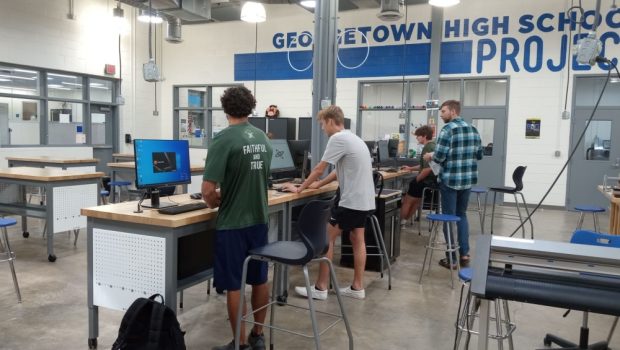Georgetown ISD’s drone program allows students to explore technology, gain license
Robert Thomas, GHS’ Eagle Innovation Center facilitator, and teacher Walker Nikolaus spearheaded the course in the 2020-21 school year.
“District administrators and the Georgetown Education Foundation have allowed us to build this program unique to our district, and we did it by doing 10 times more than what other schools do,” Thomas said.
The curriculum—championed by Thomas and Nikolaus—prepares students for a variety of drone-related industries, Thomas said.
“We want to introduce students to the design, software, programming, marketing and physical operation of drones,” Thomas said. “Because while the class is fun, we also want them to use what they learn and turn it into marketable skills.”
Senior James Barber said, while the class can be hard, it is a good way to test a variety of skills, including art, science, computer science and math.
“I’ve learned some really cool things,” Barber said.
The program also gives students the opportunity to receive their remote pilot certification from the Federal Aviation Administration.
“In order to prepare for the aviation test, we use a simulator to give students a realistic idea of what operating a drone is like,” Thomas said. “Each student must complete a successful lap ... in the sim before flying a drone in real life.”
According to the FAA, there are more than 280,000 certified remote pilots. After this school year, 31 GISD students will join that number.
“As the world moves further into automation and technology, programs like the ones offered at GISD give practical, real-world knowledge and experience to the new generations entering our workforce,” Georgetown Public Works Director Eric Johnson said.
Sophomore Allie Reusch, who took the FAA drone pilot certification test in November, said she hopes the class will set her on the right path for her future career as a pilot.
“This class made me realize that my dream is so much more realistic than I could imagine,” Reusch said.
Thomas said the drone program will relocate to GISD’s future-ready learning center when it opens for the 2024-25 school year. He also hopes to grow the program to a four-year course, giving students more time to learn and explore.
The drone program
First offered in the 2020-21 school year, Georgetown ISD's drone program falls under the career and technical education, or CTE, curriculum. Developed by GISD staff, the program is unique to the district.
Participating students learn the ins and outs of drones—designing, programming, building and operating them. The class gives students the opportunity to become FAA certified and participate in competitions.
By the end of the 2022-23 school year, Nikolaus said 31 GISD students will have obtained their remote pilot certification from the FAA.
GISD students also have the opportunity to participate in virtual competitions hosted by the Youth Drone Sports Championships. In these events, GISD students fly first-person-view drones that they have built in races and obstacle courses.
Industry demand
Data shows the global drone market is worth an estimated $30.6 billion in 2022, according to DroneII, a national research and consulting firm focused on commercial drones. Additionally, a variety of industries are taking advantage of drone technology, including agriculture, logistics, construction and real estate.
- Agriculture: Drones can be equipped with water, pesticides or herbicides that can release a predetermined amount on a specific area with the farmer watching from yards away on a screen.
- Logistics: Cargo drones are one of the only classes of drones that can make deliveries. So the distribution of parcels in overpopulated areas and medications to remote places can be timely and cost effective.
- Construction: Drones can reduce labor times for surveying land, improving infrastructure and adding efficiency to inspections.
- Real estate: Drones are able to record every inch of a property, including potential issues. This makes brokers who offer aerial drone photos and videos more attractive to buyers.
What are the different types of drones?
There are two classes of drones that are categorized by their point of view: standard and first-person-view, or FPV, drones.
Standard drones are operated by a handheld control that the pilot can attach their phone to use as a viewfinder.
FPV drones are flown by pilots wearing a set of goggles, which lets the pilot see what the drone camera is seeing.
GISD students spend the semester building a variety of FPV drones, such as:
- tiny whoop quadcopters;
- toothpick drones;
- twig drones;
- single-motor drones; and
- multimotor drones.








Gloss